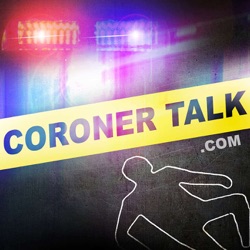エピソード
-
エピソードを見逃しましたか?
-
Due to the very nature of sudden and/or violent deaths, many things can and do go wrong in the first few hours after discovery. Death scenes have a way of bringing together many individuals with various responsibilities and experiences. This unique group can consist of uniformed officers, detectives, crime scene investigators, forensic experts, coroner investigators, medical examiner investigators, as well as prosecutors and police administrative staff.
These scenes may also have fire and EMS staff or other agencies trying to do their jobs, not to mention families and onlookers. Because of this often chaotic scene, errors can happen. Let's look at the ten most common mistakes of a death investigation.
Links mentioned in the show
Death Investigation Academy
ditacademy.org
Death Investigator Magazine
DeathInvestigatorMagazine.com
-
https://coronertalk.com/theres-a-right-way-to-be-a-coroner-and-then-there-is-the-otherThere has always been a discussion on removing coroners and rebuilding it with a medical examiner system. However, that is rarely done because it just does not work like some would hope. It is important to keep in mind the reason for these discussions usually stems from a coroner not doing their job and, in some way, negative attention gets paid to the situation or office.
As a rule, in the United States, there are two types of Coroners and Coroner offices. One is the correct way, and the other is not. In this episode, I discuss the differences, what makes a good coroner, and why the bad ones are so bad for the field overall.
-
Hoarding is a psychological condition that results in a person accumulating an enormous amount of trash and things of little-to-no value, or worse, more animals than can be properly cared for. Hoarding of any kind can pose several dangers to the occupant and neighbors, and certainly to animals if they are involved. These hazards can be deadly, and all the more reason people with hoarding disorder should have professional help to restore them to healthy living conditions. If children and animals are in the home, exposed to these perilous dangers, hoarding is also a crime.
Read More at: coronertalk.com/dangers-of-hoarding
Death Investigation Academy
https:ditacademy.org
Learn more about our Medicolegal Death Investigator Course and several other online courses.
-
A paperless office is a workplace that has minimal paper-based processes and relies on digitized documents and storage instead. This includes on scene notes and document scanning from a mobile device rather than taking the actual papers. Some Coroner offices still use pen and paper rather than a simply reporting database created for death investigations. While still other use a self-made option combining a text document and a data base software like excel or numbers.
The use of digital fingerprint scanners, document scanners, e-signatures, and cloud storage has made many offices work smarter and more efficiently. This combined with a full cloud backup reduces the amount of actual paper files stored. This works for many, and yet still many others resist the change.
In this episode Darren talks to other investigators about technology and going to a paperless office option.
Medicolegal Death Investigator Course https://ditacademy.org/mldi/This hybrid course is developed for the police detective, patrol officer, medicolegal and coroner investigator. Taught by skilled, accredited instructors working in the field of death investigation, this course will provide intermediate-level training in the skills required to properly work a death investigation. The format will develop confidence in the investigator and hone valuable skills.
After completing this course, the investigator will have the ability to better; understand the legal restriction of search and seizure, document a scene, locate and collect evidence, properly distinguish differing manners of death, better understand wound and injury interpretation, understand the dynamics of child death, conduct witness interviews, and properly complete reports and prepare for courtroom testimony.
This course will include several post-mortem examination photographs and video segments – as well as injury, death, and homicide scenes through photos and video of actual cases. This course is very graphic and intense.
-
A few years ago, the third Monday in January was labeled Blue Monday by many experts in the mental health field. But no matter what day of the week it occurs on, Anita Agers-Brooks, common trauma expert, and author of Getting Through What You Can’t Get Over, believes January 15th is a good barometer to predict the most depressing day of the year.
But why January 15th?If it takes about three weeks for a mindset to change, earmarking January 15th, 2024 ( or the third Monday) as the most depressing day of the year may just make sense. According to Brooks, based on several pieces of research she’s studied, as well as based on extensive interviews she’s conducted with everyday people, there are several contributors that solely, or linked with others, can throw even the hardiest soul into the pit of depression on or around this date.
Read more here
Death Investigator Magazine
- もっと表示する


